
This piece of art was recently sold at an auction for $ 35 million USD! No … just kidding. Read on to find out more!
For the 10th round of TGRWT I decided to modify one of my favorite pizza recipes. As it already has some blue cheese I decided that I would just add som pineapple to the sauce and see how that would work out. Knowing that pineapple works quite well on pizza (at least I have childhood memories from a pizza place called “Aloha” where they served a “Hawaiian delight” pizza with pineapple, ham and cheese) I was quite optimistic about this combination.
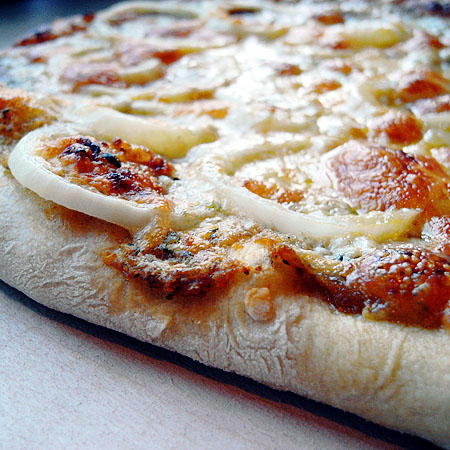
Normally I don’t use a recipe for the dough. I only remember to use 1 dL water per person. Everything else is added ad lib. But to give you a proper recipe I measured all the ingredients. Using 4 dL water gives approximately 1 kg dough in total. This gives 3 pizzas with a diameter of about 26 cm, serving 3-4 people. If you like you can roll the dough out thinner and make 4 pizzas and stretch the sauce and toppings correspondingly.
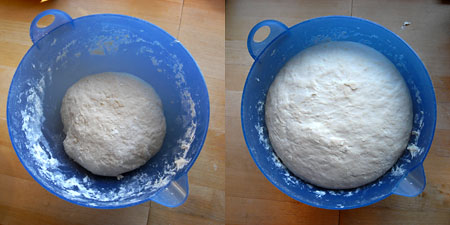
Pizza dough
4 dL water
5 g salt
5 g fresh yeast
580 g flour (plain white)
20 g olive oil
Add salt and yeast to luke warm water (~37 °C) and stir to dissolve yeast. Add flour in portions, reserving about 40 g. Mix/knead well for a couple of minutes. The dough is quite sticky. Add the olive oil. Mix/knead more. Add the remaining flour and fold the dough a couple of times. Cover and let rise for 1-2 hours.
Addition of 2% oil helps to give a lighter texture. But mix/knead the dough first so you form the gluten network before you add the oil. Otherwise the oil will cover the glutenin and gliadin proteins and inhibit the formation of gluten, rendering the dough less elastic.
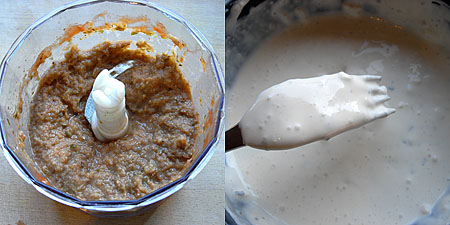
Pizza sauce
45 g sardines (I used King Oscar “Mediterranean style”)
3 t capers
2 T tomatoe paste
1 clove garlic
4 pineapple rings
Mix everything in a small food processor. (You can also add some olives if you like.)
Blue cheese sauce
75 g blue cheese
75 g crí¨me fraí®che
Crumble the blue cheese, add the crí¨me fraí®che and mix until smooth.
Toppings
1-2 onions, in rings
50 g pepperoni
100 g cheddar, grated
Assemble the pizza as follows. Roll out approximately 330 g dough and place it on a suitable pizza peel (if you forget this you won’t be able to transfer the pizza to the baking stone). Add pizza sauce, blue cheese sauce, onion rings, pepperoni and cheddar cheese. Transfer to a preheated pizza stone and bake at 250-300 °C until nicely browned. Depending on temperature this typically takes around 5-10 min.
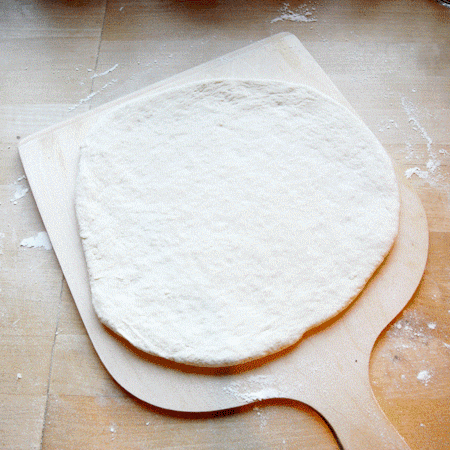
The key to a good pizza is turning up the heat! I usually set my oven around 250 °C, but you can go even higher if you like. Secondly you want to use a pizza stone (also known as a baking stone) to get that nice oven spring and a crisp crust. The picture at the top of this blog post is just a close up of my pizza stone! The black speckles are the carbonized remains of cheese and pizza sauce. I’ve blogged about the science of pizza stones previously:
A baking stone is made from a porous ceramic material. It’s heat capacity is good (much higher than that of a metal plate/sheet) and as a result, when the cold dough is placed on the baking stone, it still has enough heat to make the pizza rise immediately. Secondly, the fact that the baking stone is porous lets it absorb moisture from the pizza. This is what gives the nice crisp crust as it transports moisture away from the pizza.
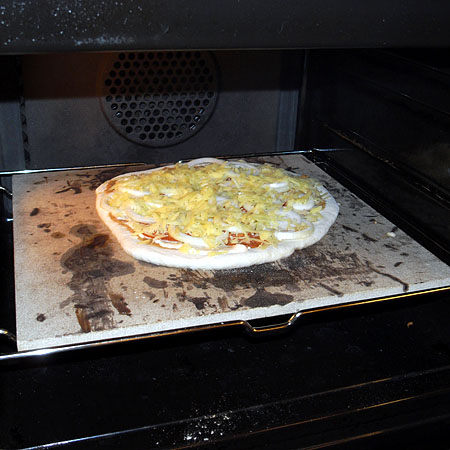
Verdict:
The original version of this pizza (without pineapple) is one of my absolute favorites and tinkering a little with the recipe doesn’t change this. But even so I felt that the pineapple diluted the pizza sauce and that the sweetness took away too much of the saltiness of the pizza sauce. Unfortunately, when making the pizza sauce, I discovered that my tube of tomato paste was empty so I used ketchup in stead. In retrospect I see that this wasn’t a good choice as ketchup is quite sweet. Therefore it’s not fair to say that all the extra sweetness came from the pineapple, but it nevertheless contributed with a lot of sweetness.
The overall flavor was very nice though, and my wife thought this pizza was better. Personally however I prefer the “original”. But perhaps next time I’ll try to add pineapple chunks in stead of churning it together with the sauce so as to concentrate the pineapple flavour more and allow it to come in small “flavor packs” now and then. I think that might work better.

Serve with red wine and a fresh salad!

You could also have used something like xanthan gum to bind up some of the loose water in the sauce. It was daring of you to try something like this where, even if pineapple and blue cheese go well together, they may clash with one of the many other bold ingredients. But it looks tasty. You can’t go wrong with pizza.
That sardine pizza sauce is an absolutely brilliant idea. Thanks for the inspiration, I’m going to try that asap.
Questions. water is by metric volume deciliter, correct?
Yes – that’s correct! 1 dL water = 100 mL = 100 g
Thanks
I really like the use of the animated gif to illustrate course of events.
If the filling is wet, it’s possible to pre-bake the dough for 1-2 min, before assembling the filling. That keeps the bottom crispy.
Great idea! Yum!
I just love the idea of this. I’ve always loved pizza with pineapple, and so this would be right up my alley. Truly inspired.
Nice flavor combo, just a pointer (typo) with the pizza base recipe, adding the salt with the yeast is not a good practice. from what i know yeast do not like direct contact with salt. maybe adding the salt at the end is a better
alternative… Great Blog No.1
It is a popular belief that salt and yeast should not be added at the same time. However Chef Simon did an experiment which shows that there is really nothing to worry about:
http://www.chefsimon.com/levselsu.htm (in French only)
or translated by Babelfish to English:
http://babelfish.altavista.com/babelfish/urltrurl?lp=fr_en&url=http://www.chefsimon.com/levselsu.htm
thankyou for the link, inspired me to conduct my own experiment.
a proper measurement of yeast activity is needed to prove or disprove this,
would it not be more accurate to measure CO2 production from yeast activity or food consumption rates.
Yes – if you have the time and equipment that is possible! But for cooking it seems that the addition of salt to yeast has no practical consequences.
[…] the production of gluten and makes the dough less elastic? I learned that from Khymos’s Pizza with blue cheese and pineapple […]
Soo… when’s 11 coming?